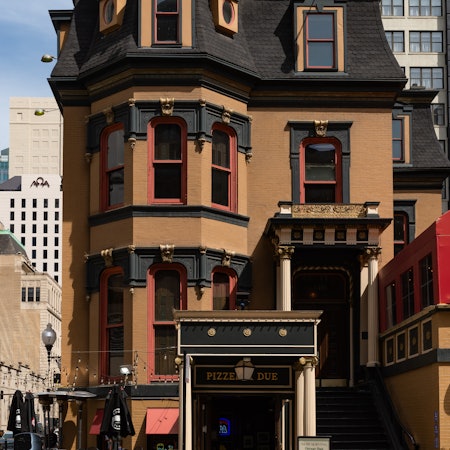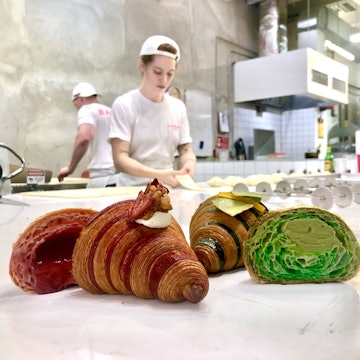
Who makes the best pizza in the US: New York, Chicago or Detroit?

May 12, 2025 • 6 min read

New York-style pizza at Joe's. Dragos Asaftei/Shutterstock
Something clicked when that delectable cheesy concoction frisbeed across the Atlantic from Italy more than a century ago.
Pizza is beer's best friend, it's a warm cardboard box on your lap as you drive home, it's a greasy slice folded in half and shoved into your mouth at 2am, it's mozzarella and tomato sauce arousing a perfect frisson from your taste buds. Let's face it: pizza just is.
Having risen from its humble origins, these days, pizza is a battleground for piazzolo (pizza chef) patriots who sprinkle everything from truffle oil to salsa chips over the pimple-faced pie. No US cities have fallen deeper in love with the pizza than New York, Chicago and Detroit – and, as in every fight for the affections of the perfect lover, the competition is cut-throat between New York's sumptuous “slice,” Chicago's “deep dish” delight and Detroit’s rectangular, caramelized crust.
So, who makes the best piece of pie? We’ll help you decide and show you where to try each style.

New York-style pizza
Gennaro Lombardi opened the first official US pizzeria at 53½ Spring St in New York in 1905. Lombardi, part of the wave of Neapolitan immigrants who settled on the East Coast, imported Naples-style pizza (a thin, casalinga, or homestyle, crust topped simply with basic ingredients such as tomato sauce and fresh mozzarella) to the Big Apple.
Italian workers would stop by Lombardi's and buy whatever they could afford, but at five cents a pie, the whole pizza was often too steep. They would receive a proportionately sized slice in a paper bag tied with string – better than mom's packed lunch any day. Lombardi's closed in 1984, but it reopened 10 years later a block down from its original location and is now a dine-in/delivery-style pizzeria with queues that can stretch around the block.
New York-style pizza – true to the elongated, narrow shape of Manhattan – is all about a thin, crunchy crust that provides a flat, almost rimless plate of pastry on which to layer the ingredients. A thin crust, coal- or wood-charred to perfection, should be singed slightly on the bottom and have a crunchy texture and smoky flavor. The best way to eat a slice is to fold the crust in half like a paper plane and let the grease squeeze out the back while you're eating it from the bottom.


Where to try New York-style pizza
L’industrie: This place has been a Williamsburg favorite since its first shop opened in 2017, and it now has a buzzy second location in the West Village. L’Industrie’s pizza can best be described as a true crispy New York slice made with premier Italian ingredients.
Rubirosa: Nab a table at Rubirosa to scarf down whisper-thin pizza crust, smothered in vodka sauce and fresh mozzarella.
Scarr’s: A retro slice shop up front and a hip sit-down for pizza, cocktails and natural wine in back. The lines are almost as legendary as the pies.
Lombardi’s: We couldn’t leave off the Nolita institution that claims to be America’s first pizzeria – it started serving Neapolitan-style, coal-fired pies in 1905.
Joe’s Pizza: A US$5 slice from Joe’s is a big step up from the questionable US$1 slice of New York legend. Trust us – the price hike is worth it. It’s the perfect example of that greasy thin slice that you immediately fold and eat outside the shop.

Chicago-style pizza
Legend has it that in the late 1800s, a Chicago street peddler balancing a metal tub filled with baked tomato pies on his head would hock pieces at two cents a portion in Little Italy. The first pizzeria – Pizzeria Uno – was opened in 1943 by Ike Sewell, an American soldier who had been stationed in Italy during WWII.
Sewell ingeniously capitalized on the returning troops' appreciation for the dish they had devoured abroad. Uno's pioneered the deep-dish style of pizza, which is assembled in a tall, round pan, starting with dough that’s pressed up the sides and filled with cheese, followed by toppings and finally topped with tomato sauce (a controversial order of assembly for many first-time diners). Chicago, a city where size matters – after all, it's the home of the first skyscraper – is big on base; the lip of the buttery crust is inches high above the dense mass of mutz (mozzarella).
Unlike New Yorkers, Chicagoans pig out on the whole pie, which they eat in a restaurant or get home-delivered. Typical of the Windy City's big business brass, Pizzeria Uno has expanded into an empire of restaurants known as Uno Chicago Grill, with franchises across the world. While a New York slice can be manhandled, Chicago pizza often requires a knife and fork to cut through the dense, gooey (but not too gooey, if it's cooked just right) goodness.


Where to try Chicago-style pizza
Lou Malnati's: This is one of the most traditional pie places in the city, churning out authentic, bready deep-dish numbers. Judging by how many of these frozen pies get shipped as “care packages” nationwide, they must be onto something.
Pizzeria Uno and Pizzeria Due: Ike Sewell supposedly invented deep-dish pizza at Pizzeria Uno in 1943, although his claim to fame is hotly contested. All we know is this place still makes a solid pie. If it's too crowded, try their sister restaurant, Pizzeria Due.
Gino’s East: In the great deep-dish pizza wars, Gino’s is easily in the top five. The owners here encourage customers to cover every available surface inside the restaurant with graffiti.
Giordano’s: A deep-dish pizza that’s a modern twist on an Italian grandmother’s legendary Easter pie.
Pequod’s Pizza: Locals love this deep dish because of its thick, chewy crusts and caramelized layer of cheese.

Detroit-style pizza
A grandchild of Sicilian-style pizza, Detroit’s rectangular pie was born in 1946, when Gus Guerra, owner of then-neighborhood bar Buddy’s Rendezvous, asked his wife, Anna, to develop something fresh for the bar’s menu. Anna followed her Sicilian mother’s pizza dough recipe and topped it with cheese and tomato sauce in a deep, rectangular steel pan, which Gus borrowed from a local automotive plant.
The result was a chewy, airy dough with crispy, caramelized and cheesy edges. It’s not uncommon to fight over who gets a coveted corner slice (aka, double the mouthwatering crust). The classic version is topped with brick cheese, toppings and red sauce. Some diners prefer sauce underneath the toppings, though Buddy’s original recipe calls for adding stripes of the cooked red sauce as the final step. While Detroit pizza joints can get creative with toppings, pepperoni is definitely the most popular. It’s especially satisfying when the pepperoni is thick and crisps into a cup-like shape in the oven.
Known today as Buddy’s Pizza, the famous founding pizzeria still serves up the same fluffy-yet-crispy pies.


Where to try Detroit-style pizza
Michigan & Trumbull: It’s perhaps ironic that the place serving the best homage to Guerra’s Detroit-style pizza was founded in Pittsburgh – albeit by two Detroit natives. The pies here have innovative topping builds like the Long Drive Home (a rich combination of vodka sauce, mozzarella, Parmesan, sausage and banana peppers).
PieSci Pizza: Great for the classics, but they also serve up delicious vegetarian, dairy-free, vegan and gluten-free pizzas. PieSci updates their menu seasonally, so there’s always something new to try.
Buddy’s Pizza: The original Detroit pizza spot is still kickin’ for a reason. Go for one of their signature squares, like the Super 6 Mile, which is topped with Wisconsin brick cheese, pepperoni, ham, onions, peppers and mushrooms.
Jet’s Pizza: Jet’s also does more traditional round pizzas, though you’d be remiss to skip out on the deep-dish pie that brought the establishment to fame. They make their light and airy dough in-house daily.















